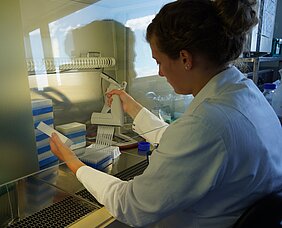According to the fertilizer ordinance of May 26, 2017, urea may only be used as fertilizer "after February 1, 2020, if a urease inhibitor has been added to it or if it is applied immediately, but no later than four hours after application". Since the interaction of urease inhibitors with microbiology and groundwater is poorly understood, field and laboratory scale experiments were conducted in this project to fill this knowledge gap.
The objective of this project was to characterize the interactions between urease inhibitors and microbiology. In addition, the general admixture was to be investigated and information on potential leaching to groundwater was to be provided. The most relevant parameters for site assessment had to be identified and a transferable monitoring strategy had to be derived.
As part of the project, soil samples were taken from arable land in two water protection areas that had been fertilized with urea with and without urease inhibitors.
After the addition of the stabilized fertilizer in the field and in lysimeters, and after the addition of the urease inhibitors 2-NPT and NBPT in microcosm experiments in the laboratory, no significant effect on the microbiology could be demonstrated using microbiological and molecular biological parameters compared to control experiments without inhibitors. The spiked urease inhibitors 2-NPT and NBPT were still above the limit of quantification in the microcosms after 50-150 days.
For the urease inhibitor 2-NPT, partial migration from the topsoil to the subsoil was observed in field and lysimeter studies. At present, it cannot be excluded that metabolites of urease inhibitors are formed and may be transferred from the topsoil to deeper areas.
It is recommended not to use such fertilizers (with inhibitors) over large areas in a water catchment area. There are other ways to reduce ammonia emissions. Based on current knowledge, the use of slow-release fertilizers or the immediate incorporation of urea fertilizers or the use of alternative fertilizers should be preferred.

![[Translate to English:] Prüfstelle-Produktprüfung_Teststand Test centre and product testing](/fileadmin/_processed_/0/9/csm_TZW-Karlsruhe_Pruefung_Geraete-Teststand_377188946c.jpg)

























